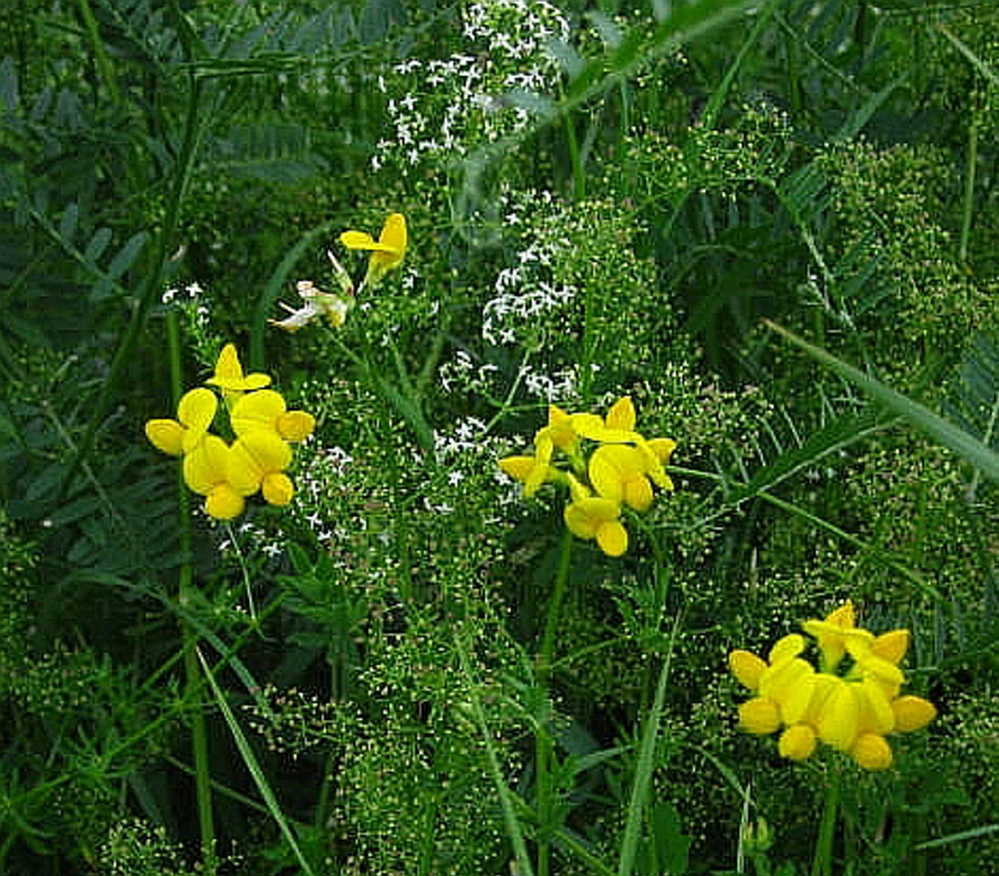July again. Summer, somewhat unbelievably, is already making its cosmic pivot out of highlong sun toward blackshadow August and full, gold autumn.
Suddenly the grass has topped out and gone to seed. Like a blind-sideways blow, the supernatural green explosion of May and June has already turned into the first twinkles of meadowsweet.
First daisies, cow vetch and buttercups crept in like stars emerging out of twilight, fleabane like multiple-sun systems on green stalks overseeing it all. The apparition of hawkweed faces in crowds, like a neater make of dandelion. Yarrow, bedstraw, water hemlock (fatal), and field groves of three-umbeled pastel valerian. Big tangles of lavender-blue crown vetch.
Suddenly all kinds of three-leaf clovers, white, red, hop and rabbit-foot, appear as if they fell out of the sky. The middle moment of summer turns its axis over those few days when dust-pink cascades of milkweed blossoms open up. The stitchwort, like galaxies on tendrils in the talling grass, acts like a psychedelic drug on the mind errant. This all happens by the middle of July.
This month the really blinding weed, for unknown reasons, has been the birdsfoot trefoil. Little tripartite lip-flowers that grow in yellow crowds near pavement and fences. Lotus corniculatis, the botanists call them. How the genus “Lotus” got there, I don’t know. The guides say they were introduced from Europe, but I think their origins were further out, somewhere the other side of the Buddhist pure lands. This is the kind of flower, who, after you stare at a patch long enough, you swear has come from outer space.
Maybe it all did. Some astrobiologists think life on Earth began when comets sprayed in through the atmosphere carrying chemicals believed to be the precursors of sentient beings. Amino acids — organic molecules basic to the chemistry of life — have been found on plenty of meteorites, and recent experiments have shown that linked pairs of them (dipeptides) are chemically viable in outer space conditions, and could have ridden to Earth on comet dust and catalyzed proteins, enzymes and sugars into life.
It’s less far-fetched than it sounds. Some scientists say a meteorite that crashed onto Sri Lanka in 2012 has algae fossils, and arguments have been made that microscopic fossils are visible in meteorites that were blasted off Mars millions of years ago and later fell to Earth in Antarctica and Egypt.
Panspermia, the theory is called, that suggests life is being pervasively distributed throughout the universe on comets and other traveling chunks of rock and ice.
I don’t know, of course. I only know that the bright yellow birdsfoot trefoil along the roadside at the Unity park, when seen in a certain slant of mind, has an otherworldly glow about it that stings the inner eye and opens up a momentary conduit connecting flower blossom to places like the Trifid nebula, where stars are spinning up out of clouds of dust and appearing in deep space the way flowers spin up in grass and carry starlight into the edge of midsummer.
Dana Wilde lives in Troy. His writings on Maine’s natural world are collected in “The Other End of the Driveway,” available from Booklocker.com. Backyard Naturalist appears the second and fourth Thursdays each month. You can contact him at naturalist@dwildepress.net.
Send questions/comments to the editors.




Comments are no longer available on this story